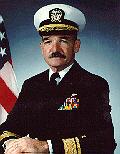

Lieutenant T.G. "Spuds" Ellyson qualified in the Navy's first aircraft in 1911, giving birth to Naval Aviation. Since then, an enduring reality has been Naval Aviation's constant adaptation to our changing world. Naval Aviation has always embraced change, and change has served us well. As the world situation changed or technology advanced, Naval Aviation was able to adapt and improve. This adaptability and flexibility have allowed us to remain the force of choice - ready to go in harm's way when the President asks, "Where is the closest carrier?" This publication is the result of many thoughtful discussions and a lot of hard work by our Strategic Long-Range Vision team. The team was composed of Fleet aviators from all communities in Navy and Marine Corps Aviation with a strong representation from the junior officer corps. Working diligently over a nine month period, the team conducted a thorough review of what Naval Aviation will be required to do in the context of future geopolitical strategic environments. The team's objective was to take an intensive look at the way we do business and how we can improve Naval Aviation to keep us vital and relevant to our nation's security needs. The team's review was wide ranging - from how we are organized to future budgets to technology trends - including everything from how we recruit and train people to how we supply and sustain. Our goal was to produce a document that would take a balanced and all-inclusive approach to Naval Aviation - one which we can all truly claim ownership. I thank the entire team for their work in producing this document and for their continuing refinement of Naval Aviation's course to the future.
The dramatic changes of the last several years and the subsequent reorientation of our naval strategy, as articulated in Forward...From the Sea and ...From the Sea, toward an expeditionary force are serving the nation well. One of our major conclusions is that this strategy remains relevant. There is no need for a major reinvention of Naval Aviation. We must, however, leverage technology and innovation to exploit capabilities in information warfare, precision strike and operational maneuver. In this era of information technology and open global markets, a potential adversary has the ability to easily obtain sophisticated weapon systems. Our challenge is to remain two steps ahead of him. This dangerous and unpredictable world will mean that our unique, unencumbered forward presence will be even more critical in the 21st century. Because of our expeditionary nature and flexible air power, forward from the sea, Navy and Marine Corps Aviation is - and will remain - the force of choice.
Dennis V. McGinn
Rear Admiral, U.S. Navy
Director, Air Warfare Division (N88)